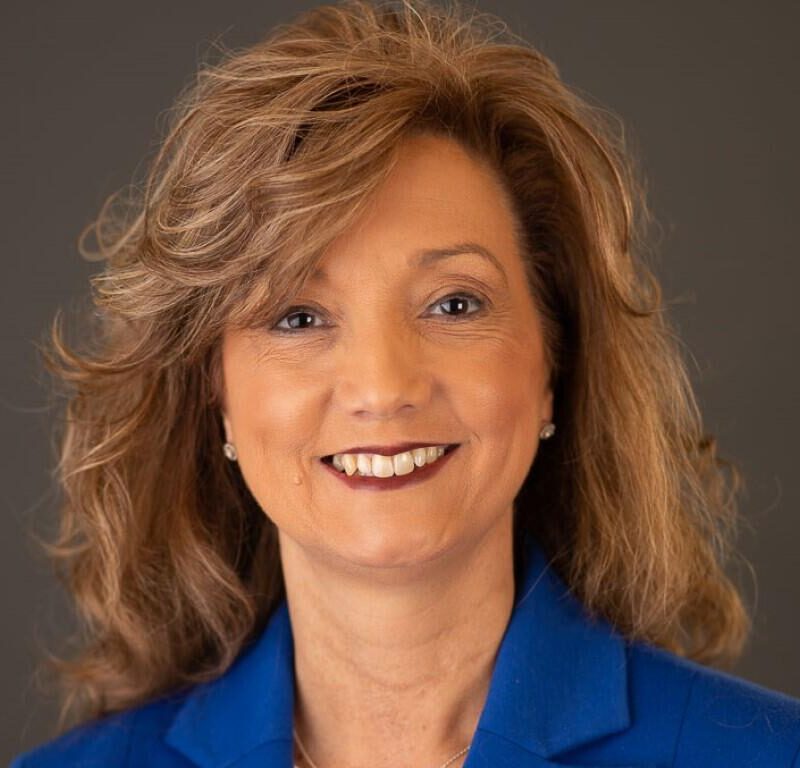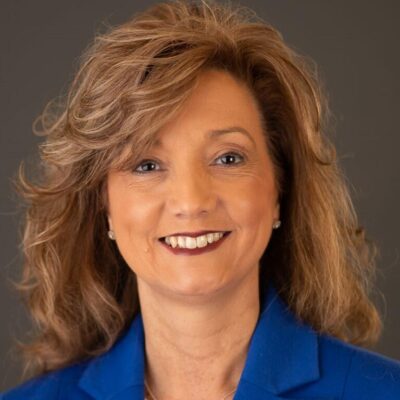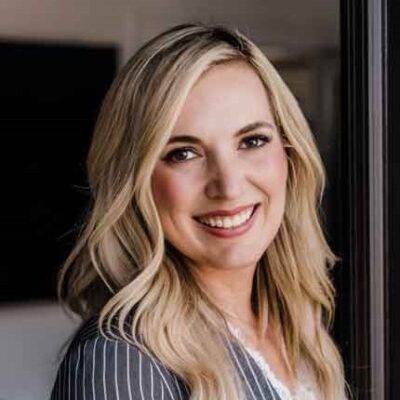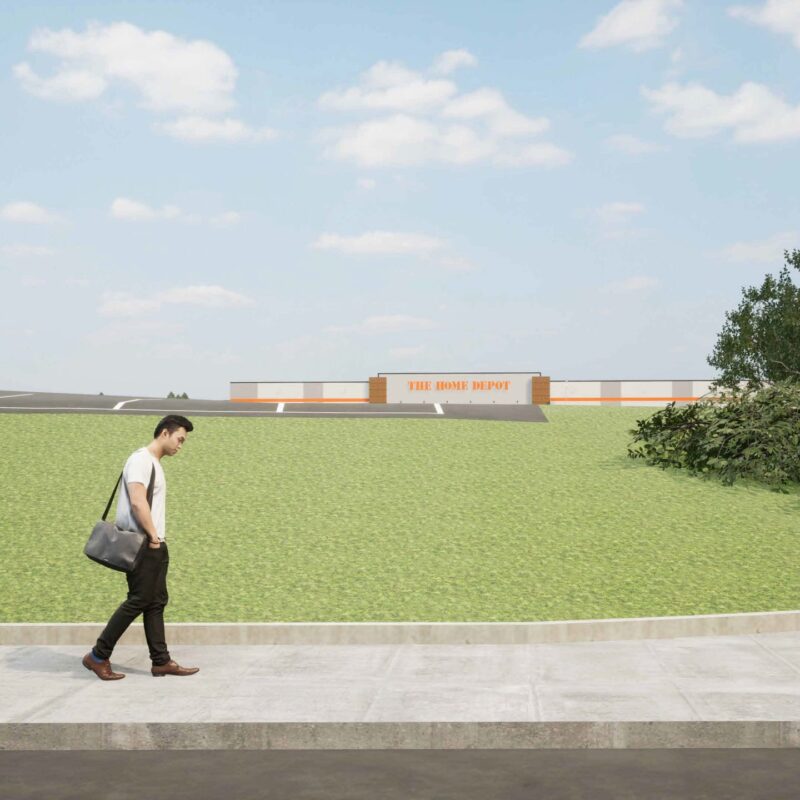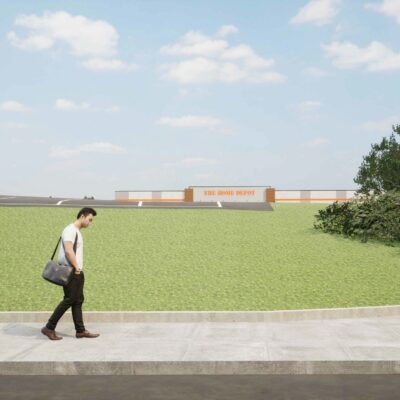Art galleries are a bit like the Hokey Pokey—either your left foot is headed in, or your left foot is out. Maybe you’re the type of person that makes time in your life to see John Doe Michelangelo’s latest oil paintings, and maybe you’re not. These two types of people are as separate as collage and Crayola. It’s that simple; no need to shake it all about.
| Brendan Fitzgerald gives a video tour of some of the works of art in "The Other Show" at PVCC. |
But shaking it up means progress. Think Bob Dylan going electric at the Newport Folk Festival in 1965, or Orson Welles moving from the radio chaos of “War of the Worlds” to the big screen for Citizen Kane. During a span of 20 years, Pablo Picasso jumped from Blue Period to Rose Period to African Period to Cubism. Ehrich Weiss was already a magician by the time he changed his name to “Harry Houdini,” but the new label gave the performer a second, and greater, act.
 “Connect the Skull,” one of Noah Scalin’s “Skull-A-Day” designs on display at “The Other Show” at PVCC. |
“The Other Show,” the current art show at Piedmont Virginia Community College that runs through August 21, is based on the space between vision and revision, the move from a comfortable idea towards a less comfortable one. Curator and local artist Rob Tarbell collected 40 pieces of art from 20 artists—one exemplary of each person’s style, and another that strays from each person’s norm. “I asked fellow artists, ‘What do you do?’ But I followed with ‘What else?’” Tarbell writes in a book accompanying the exhibit. “And the answer was always interesting.”
Tarbell’s collection of oddities is a mental maze of a show, a mix-and-match of the usual and the “un-.” It also may be one of the city’s most exciting and interactive art shows in years. The only thing missing until now is a primer. C-VILLE spent a few days at “The Other Show,” and let it turn us all around. Here’s what it’s all about.
1. Bring your running shoes
 |
For those of you that haven’t been, the PVCC’s V. Earl Dickinson Building is shaped like a large circle. Works for “The Other Show” line the perimeter, with one work by each artist on each side. This encourages the feeling of running around the track at your high school, but the exhibit rewards legwork. Let yourself dash back and forth between the two halves of the circle, gulping air while trying to find which two wildly disparate pieces come from the same artist. A curious mind and quick legs pay off for art fans that want to find each artist’s two creations. Which brings up point No. 2…
2. Treat it like a scavenger hunt
The 40 pieces in “The Other Show” aren’t linked in ways you’d expect; the exhibit requires a bit of mental flexibility. And, although each artist takes a logical step from their usual medium or subject or style to their “other” effort, it might be a step backwards, or sideways, or off the side of a cliff.
 “Action to Object,” a sculpture by Brad Birchett |
Take Brad Birchett’s two contributions. An associate professor of art at Virginia Commonwealth University, Birchett takes the urban grid of Richmond as his inspiration for two pieces, “Action to Object” and “Urban Renewal.” The first is a cairn—a pile of rocks that denotes a pathway or a burial site—that plays a recorded loop of a one-hour walk by Birchett during his journey to collect the stones. The second is a set of 12 small paintings, fragmented and scarred, that resembles evenly spaced tenement houses or groupings of mountains along the Appalachian Trail.
 “Urban Renewal,” Birchett’s second contribution to “The Other Show” |
In short, use the Dickinson Building as the grounds for your scavenger hunt. Bring a few friends, start on one side of the gallery space, look at everything, then sprint to the opposite side. Avoid the placards with the artists’ names—that’s like cheating. Mention clues conspiratorially to your fellow explorers. Take a red pen to the pricing list and use it like a checklist for your finds. Here are a few to get you started:
Who is the only artist to show two pieces on the same side of the gallery?
What artist’s work hangs alongside pieces from his mother and father?
Which artist attended the University of Virginia in 1988? (Hint: See No. 9.)
3. Radio, radio
When you first arrive at the Dickinson Building, remain in your car. Turn the radio frequency to either 98.9FM or 101.3FM and, for the next 10 minutes, keep your eyes closed as the radio broadcasts the noise of impending disasters—wreckage by wind, water, fire, all of the natural elements.
The woman behind that sonic manipulation, “Vague Apocalypse,” is Alyssa Salomon, and she is primarily a photographer. The northern portion of the PVCC gallery is filled with her daguerreotypes, photos developed on the chemical compound silver halide that bear names like “Nothing, Blue Skies” and kinda resemble holograms.
Yet “Vague Apocalypse” arguably nabbed Salomon more attention, including a 2007 “Best in Show” nod from the Contemporary Art Center of Virginia. Tarbell says that “Vague Apocalypse” and the daguerreotypes are both examples of antiquated technology, outdated media, but that’s not the only connection between Salomon’s work. While one radio transmitter hidden in the PVCC gallery broadcasts disaster after disaster, another plays Irving Berlin’s “Blue Skies.” This radio broadcast will continue, 24 hours a day, until the show ends in late August. Forecast: Blue skies, with a 50 percent chance of annihilation. You’ve been warned.
4. Meet your maker
One of Rob Tarbell’s eyes is two different colors, which seems an appropriate metaphor for “The Other Show.” A tall, stubbly bear of a man, Tarbell both moves and talks with a studied calm that could make a golfer swoon. His own work is an equally unlikely pairing of savagery and grace: His “Smokes”—large canvases that look painted in black breath—can be seen at Les Yeux du Monde. In February, he displayed a collection of stuffed rabbits, bears and gorillas at Second Street Gallery that he de-stuffed then packed with porcelain and baked, creating a zoo of eerie, ivory-colored creatures.
Tarbell splits his time between Richmond and Charlottesville, working as an adjunct professor of art at both VCU and PVCC; he is represented by galleries in both cities as well, from LYDM in Charlottesville to the 1708 Gallery in Richmond, where he serves on the gallery’s board. In short, Tarbell is neither here nor there, not wholly of one place or medium. The perfect mad scientist for the show; if you spot him at the gallery, pull him aside and ask for a tour.
5. Eat up!
Amidst this glut of art, you’ll find evidence of that other medium that we most casually experiment with—food.
Chris Norris unleashes his other half as part of a six-person artist collective called FEAST, a confectioner’s dream and a diabetic’s nightmare. FEAST was originally conceived as a photography group; Norris’ other piece, “Drunk on Doughnuts,” depicts a buxom brunette licking her dainty, aristocratic fingers before a pile of sweets. But the ensemble’s exhibits evolved into cream-filled, frosted puff pastries of performance art, in which women dressed in red satin distribute candy and keep tables of brownies and Twinkies fully loaded. The spread in “Drunk on Doughnuts” is a rich one, but the model is restrained; the photo is a nice counterpart to Norris’ “Crown of Swans,” an ornate painting in which a trio of swans rise from the head of a deer, hissing and spitting, wild and unruly in a way that the gluttonous woman struggles to resist.
Jake Urbanski is a bit more straightforward when it comes to playing with food. As part of the Ink Tank collective (founded in part by Matt Lively; see No. 6), Urbanski and a crew of friends painstakingly scanned meats, cheeses, breads and other fixings, then set up a lunch counter in which they “prepared” meals for customers by printing their desired munchies onto t-shirts. A sample of this buffet is on display on one side of the gallery.
 A selection from the “Meat shirts” menu, a series of custom t-shirt concoctions by Jake Urbanski. |
In “4 Unhappy Children,” however, Urbanski gets a bit more meditative. By staining light-sensitive photograph paper with blue and red popsicles, Urbanski offers a painting that is designed to decompose as it is exposed to light. (Prior to the show’s opening, Urbanski’s piece was covered by a cloth to keep it from changing colors.) There is also a digital print of the original popsicle painting so gallery goers can compare the two. As the sticky-fingered artist offers in his statement accompanying the show, “[Viewers] must consider whether they would want to own the original image and accept the inevitable change…[or] a part that would remain unchanged indefinitely.” Dig in.
 An example of Urbanski’s "other" work, light-senstitive popsicle prints. |
6. What’s the Matt-er?
“Hew.” Verb. To cut or to separate one thing from another. The only difference between “Matt Lively” and “Matthew Lively,” folks, is a “hew.”
On one side of the gallery is Matt Lively’s standard fare, an oil painting called “Flight.” The painting is one in a series of surreal suburban scenes in which 1940s homes and fixtures take on personalities and become characters in front of a background of comically sinister gray skies. The scenes are playful, reminiscent of both Virginia Lee Burton’s The Little House children’s book and California painter Mark Ryden, who illustrated a pair of Stephen King book jackets depicting cartoon-inspired neighborhoods. The full scope of Lively’s work is online at www.mattlively.com.
 “Flight,” a painting by Matt (not “Matthew”) Lively. |
Not to be confused with www.matthewlively.com, where work from Lively’s 2006 show at Richmond’s Art6 Gallery, “Dead/Alive”—a collection of 72 sculpted sheep and various paintings of the bleating bags of wool—is on display. “Matthew” Lively contributes “Abide,” a piece originally conceived for the “Dead/Alive” show that shares a palette with Matt Lively but a hazy, more ethereal style. Of the artists in “The Other Show,” Matt Lively may be the only one to submit another personality as his project. What a difference a “hew” can make.
7. Cross bones
On June 3, Noah Scalin completes his “Skull-A-Day” project (skulladay.blogspot.com), an undertaking that earned the graphic artist both a 2008 Webby Award and a book deal. (Lark Books plans to publish Skull, documenting Scalin’s work; see page 19 to connect the skull.) Scalin has a graffiti artist’s obsession with the simple image; images from his blog run on a video loop at PVCC and contain skulls hidden in tea leaves, Tinkertoys or human hands.
Scalin offers a number of cultural and historical interests in skulls—the Mexican Day of the Dead, modern gothic culture, works by Damien Hirst and Hans Holbein. In the preface to the forthcoming Skull, Scalin writes that demanding an original skull from himself each day was like a dare to see an image of death in everything: “Lacking a societal alternative, my project became my own daily meditation on death.”
Not that Scalin is a particularly glum fellow. His other work, part of a project called “Plant The Piece” (www.plantthepiece.com) is a collection of 9mm handguns filled with seeds, one gun for each of the 101 gun-related murders committed in Richmond in 2004. Two of the seed guns are on display at PVCC, one inside the gallery and one outside, where it can take root and fire.
Speaking of the great outdoors…
8. You missed a few!
“The Other Show” begins well before you step inside the gallery, starting with the excavation site to the left of the gallery’s entrance—a series of long, slender holes carved into the ground, illuminated by a construction light. On the opposite side is a collection of rough metal sculptures made by Daniel Calder to evoke “pig irons,” a compound metal that can be easily melted down and reshaped. “The Pigs and Pig Bed,” as Calder calls this two-part installation, are frozen in their present form; inside the gallery, “Avoidance,” an abstract painting of obscured vertical bars, evokes the same turmoil of melting down iron rods into a malleable substance.
 “Avoidance,” an acrylic painting by Daniel Calder. “Avoidance,” an acrylic painting by Daniel Calder. |
And, in the grass a few dozen steps from the gallery’s entrance, you can find Allison Andrews’ “H2,” a 7′ by 6′ by 17′ scale model of a Hummer framed by metal bars, but otherwise completely transparent. Primarily a sculptor, Andrews’ other work, a video reimagining of the Preamble to the U.S. Constitution shown over audio clips of The Lord’s Prayer and the Islamic call to prayer, is an interesting idea, but lacks the wallop of her invisible gas guzzler parked on the front lawn.
9. Sticky situations
Gordon Stettinius is one of the only participants (not counting Tarbell) with a local connection. He graduated from UVA in 1988 before moving to Richmond, where he is an adjunct faculty member at VCU as well as a former president of the 1708 Gallery, where many of “The Other Show”’s artists have previously exhibited.
 “Burlesque,” a blood silkscreen by Gordon Stettinius. “Burlesque,” a blood silkscreen by Gordon Stettinius. |
A photographer frequently drawn to the human form, Stettinius chose to put a little bit of himself into his other work—namely, by drawing blood from himself and substituting it for the ink in a silk-screen procedure. As a result, “Burlesque”—a rapturous nude photograph—is given the lurid, sinful tone its name commands.
“Burlesque” is one in a series of prints that Stettinius has manipulated with unconventional materials. Rather than waiting for Crayola to issue colors like “Pepto Pink” or “Translucent Blue Detergent,” he has used the raw materials—molasses and chocolate syrup, honey, salad dressings and olive oils, and the aforementioned products—to draw some unnatural convergence of subject and object out of each work.
10. Lose your marbles
We don’t mean literally. Unless, of course, you’ve found Tommy White’s “Marble Boy,” a wooden structure based on a ghost story about a child that haunts Savannah College of Art and Design, playing a creepy game of keepsies while he shoots his marbles around the rafters. At the base of White’s painted box is a drawer filled with marbles of different weights that trigger different latches and levers within the box when dropped into the top. Roll one down the chute and spook yourself.
 One of Jesionowski’s “Topographies,” a series of mixed-media drawings One of Jesionowski’s “Topographies,” a series of mixed-media drawings |
“The Others Art Show” is as interactive and joyful as a kid’s game, as inventive as a ghost story or tall tale, something that simultaneously dares and delights its creators and audiences. Flip through Rosemary Jesionowski’s two-sided postcards, with which she asked friends and strangers “Where are you going? Where are you from?,” then peek at her “Topographies,” which have never been show before. Peer inside Cindy Neuschwander’s equally secretive handmade books, originally composed for the eyes of her husband alone. Try to mentally piece together Robert Walz’s “Disassembly,” a deconstructed collection of model kits, then ask yourself how it might connect to his unobtrusive, polycarbonate ladder, titled “Closer.” (Hint: Walz loves lucite—look for it.)
 A selection of postcards from Rosemary Jesionowski’s “Where Are You Going, Where Are You From?” |
It isn’t a normal art show any more than the Dickinson Building is a normal gallery or Tarbell’s collection of artists is a normal group of people. But before we’re distracted—by the same old thing or something new, by normalcy or the other—we can all take a walk on the wild side.
 “Disassembly,” a giclee print by Robert Walz. “Disassembly,” a giclee print by Robert Walz. |
 “Marble Boy,” a rattling, interactive mixed-media piece from Tommy White. |
